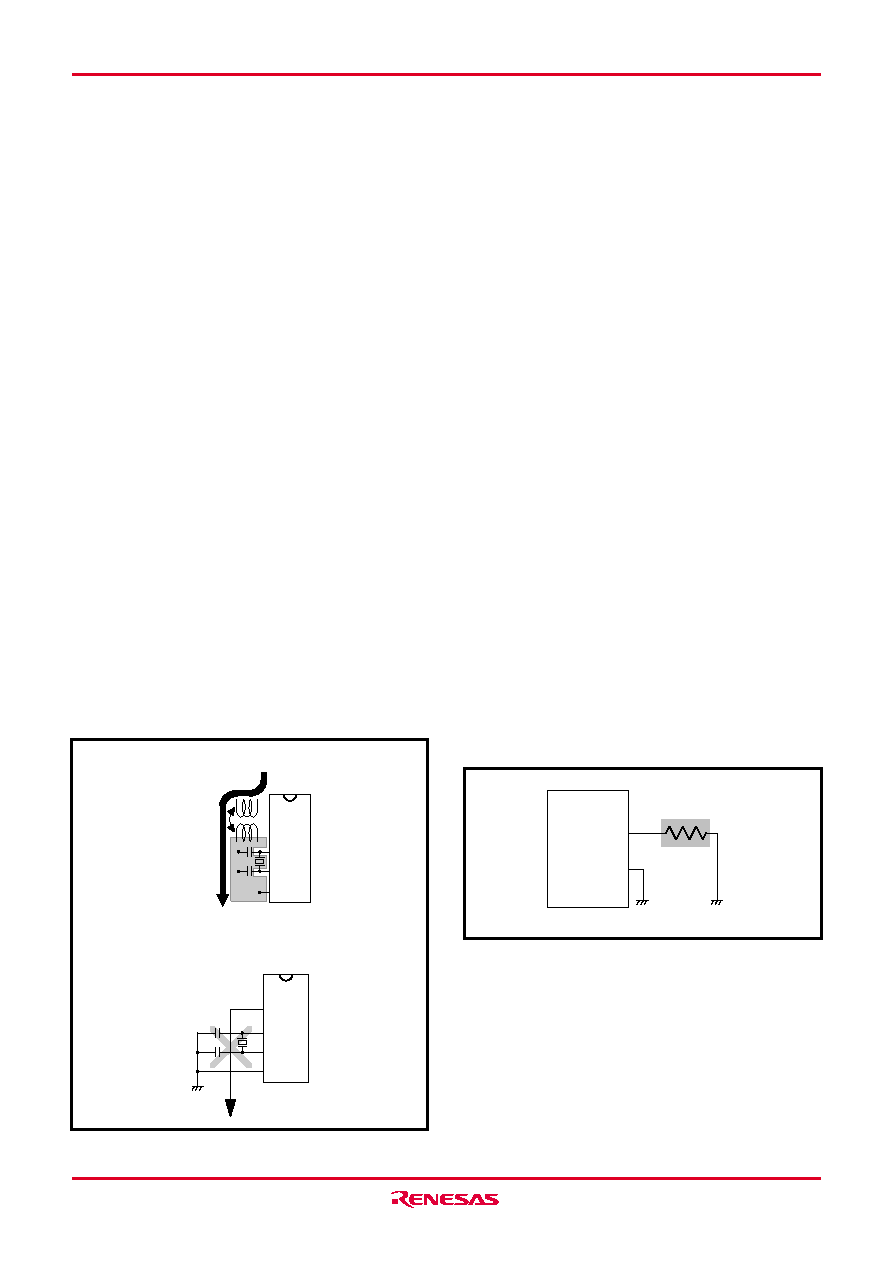- 您現(xiàn)在的位置:買賣IC網(wǎng) > PDF目錄45047 > M38C13E6HP 8-BIT, OTPROM, 4 MHz, MICROCONTROLLER, PQFP64 PDF資料下載
參數(shù)資料
| 型號(hào): | M38C13E6HP |
| 元件分類: | 微控制器/微處理器 |
| 英文描述: | 8-BIT, OTPROM, 4 MHz, MICROCONTROLLER, PQFP64 |
| 封裝: | 10 X 10 MM, 0.50 MM PITCH, PLASTIC, LQFP-64 |
| 文件頁(yè)數(shù): | 39/59頁(yè) |
| 文件大小: | 704K |
| 代理商: | M38C13E6HP |
第1頁(yè)第2頁(yè)第3頁(yè)第4頁(yè)第5頁(yè)第6頁(yè)第7頁(yè)第8頁(yè)第9頁(yè)第10頁(yè)第11頁(yè)第12頁(yè)第13頁(yè)第14頁(yè)第15頁(yè)第16頁(yè)第17頁(yè)第18頁(yè)第19頁(yè)第20頁(yè)第21頁(yè)第22頁(yè)第23頁(yè)第24頁(yè)第25頁(yè)第26頁(yè)第27頁(yè)第28頁(yè)第29頁(yè)第30頁(yè)第31頁(yè)第32頁(yè)第33頁(yè)第34頁(yè)第35頁(yè)第36頁(yè)第37頁(yè)第38頁(yè)當(dāng)前第39頁(yè)第40頁(yè)第41頁(yè)第42頁(yè)第43頁(yè)第44頁(yè)第45頁(yè)第46頁(yè)第47頁(yè)第48頁(yè)第49頁(yè)第50頁(yè)第51頁(yè)第52頁(yè)第53頁(yè)第54頁(yè)第55頁(yè)第56頁(yè)第57頁(yè)第58頁(yè)第59頁(yè)

Rev.2.40
Jun 14, 2004
page 44 of 56
38C1 Group
(3) Oscillator concerns
In order to obtain the stabilized operation clock on the user system
and its condition, contact the oscillator manufacturer and select
the oscillator and oscillation circuit constants. Be careful espe-
cially when range of voltage or/and temperature is wide.
Also, take care to prevent an oscillator that generates clocks for a
microcomputer operation from being affected by other signals.
Keeping oscillator away from large current signal lines
Install a microcomputer (and especially an oscillator) as far as
possible from signal lines where a current larger than the toler-
ance of current value flows.
q Reason
In the system using a microcomputer, there are signal lines for
controlling motors, LEDs, and thermal heads or others. When a
large current flows through those signal lines, strong noise oc-
curs because of mutual inductance.
Installing oscillator away from signal lines where potential levels
change frequently
Install an oscillator and a connecting pattern of an oscillator
away from signal lines where potential levels change frequently.
Also, do not cross such signal lines over the clock lines or the
signal lines which are sensitive to noise.
q Reason
Signal lines where potential levels change frequently (such as
the CNTR pin signal line) may affect other lines at signal rising
edge or falling edge. If such lines cross over a clock line, clock
waveforms may be deformed, which causes a microcomputer
failure or a program runaway.
Keeping oscillator away from large current signal lines
Installing oscillator away from signal lines where potential
levels change frequently
Fig. 48 Wiring for the VPP pin of One Time PROM
Fig. 47 Wiring for a large current signal line/Wiring of signal
lines where potential levels change frequently
XIN
XOUT
VSS
M
Microcomputer
Mutual inductance
Large
current
GND
XIN
XOUT
VSS
CNTR
Do not cross
N.G.
(4) Analog input
The analog input pin is connected to the capacitor of a voltage
comparator. Accordingly, sufficient accuracy may not be obtained
by the charge/discharge current at the time of A/D conversion
when the analog signal source of high-impedance is connected to
an analog input pin. In order to obtain the A/D conversion result
stabilized more, please lower the impedance of an analog signal
source, or add the smoothing capacitor to an analog input pin.
(5) Difference of memory type and size
When Mask ROM and PROM version and memory size differ in
one group, actual values such as an electrical characteristics, A/D
conversion accuracy, and the amount of -proof of noise incorrect
operation may differ from the ideal values.
When these products are used switching, perform system evalua-
tion for each product of every after confirming product
specification.
(6) Wiring to VPP pin of One Time PROM version
Connect an approximately 5 k
resistor to the VPP pin the shortest
possible in series and also to the VSS pin.
Note: Even when a circuit which included an approximately 5 k
resistor is used in the Mask ROM version, the microcom-
puter operates correctly.
q Reason
The VPP pin of the One Time PROM version is the power source
input pin for the built-in PROM. When programming in the built-in
PROM, the impedance of the VPP pin is low to allow the electric
current for writing flow into the built-in PROM. Because of this,
noise can enter easily. If noise enters the VPP pin, abnormal in-
struction codes or data are read from the built-in PROM, which
may cause a program runaway.
CNVSS/VPP
VSS
About 5k
相關(guān)PDF資料 |
PDF描述 |
|---|---|
| M38C13M6-XXXHP | 8-BIT, MROM, 4 MHz, MICROCONTROLLER, PQFP64 |
| M38C12M4-XXXFP | 8-BIT, MROM, 4 MHz, MICROCONTROLLER, PQFP64 |
| M38C13M6-XXXHP | 8-BIT, MROM, 8 MHz, MICROCONTROLLER, PQFP64 |
| M38C12M4-XXXHP | 8-BIT, MROM, 8 MHz, MICROCONTROLLER, PQFP64 |
| M38C13E6FP | 8-BIT, OTPROM, 8 MHz, MICROCONTROLLER, PQFP64 |
相關(guān)代理商/技術(shù)參數(shù) |
參數(shù)描述 |
|---|---|
| M38C13RLFS | 制造商:Renesas Electronics Corporation 功能描述:EMULATION MCU/8BIT CMOS EMULATION CHIP - Bulk |
| M38C24M4-XXXFP | 制造商:MITSUBISHI 制造商全稱:Mitsubishi Electric Semiconductor 功能描述:SINGLE-CHIP 8-BIT CMOS MICROCOMPUTER |
| M38C24M4-XXXHP | 制造商:MITSUBISHI 制造商全稱:Mitsubishi Electric Semiconductor 功能描述:SINGLE-CHIP 8-BIT CMOS MICROCOMPUTER |
| M38C24M6-051HP | 制造商:MITSUBISHI 制造商全稱:Mitsubishi Electric Semiconductor 功能描述:SINGLE-CHIP 8-BIT CMOS MICROCOMPUTER |
| M38C24M6-XXXFP | 制造商:MITSUBISHI 制造商全稱:Mitsubishi Electric Semiconductor 功能描述:SINGLE-CHIP 8-BIT CMOS MICROCOMPUTER |
發(fā)布緊急采購(gòu),3分鐘左右您將得到回復(fù)。